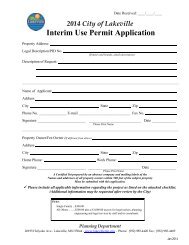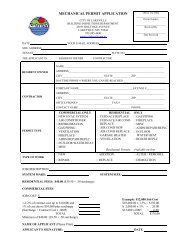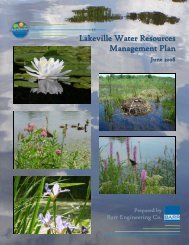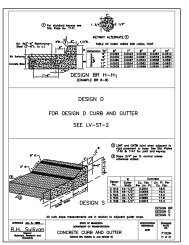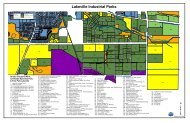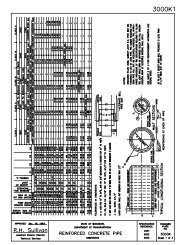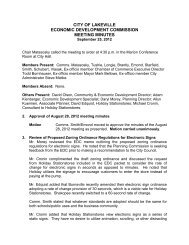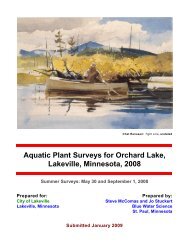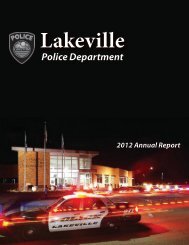2006 Parks, Trails and Open Space Plan - City of Lakeville
2006 Parks, Trails and Open Space Plan - City of Lakeville
2006 Parks, Trails and Open Space Plan - City of Lakeville
You also want an ePaper? Increase the reach of your titles
YUMPU automatically turns print PDFs into web optimized ePapers that Google loves.
Chapter<br />
3<br />
Inventory <strong>of</strong> Existing Park, Trail & <strong>Open</strong> <strong>Space</strong> Facilities<br />
The <strong>City</strong> <strong>of</strong> <strong>Lakeville</strong> is serviced by a variety <strong>of</strong> recreational facilities provided by the<br />
city, regional government, school districts <strong>and</strong> private enterprise. In addition, the<br />
community has limited benefits from abutting communities whose facilities may service<br />
<strong>Lakeville</strong>’s residents. This chapter summarizes these existing parks, trails <strong>and</strong> open<br />
space facilities <strong>and</strong> the resources currently available to <strong>Lakeville</strong> residents.<br />
Existing Park Classification System<br />
<strong>Lakeville</strong>’s park system is comprised <strong>of</strong> a variety <strong>of</strong> sites & facilities which conform to a<br />
classification hierarchy according to their use, size <strong>and</strong> facility development. Park<br />
classification assists in providing a comprehensive system which responds to the<br />
community’s needs, its l<strong>and</strong>-use patterns <strong>and</strong> densities <strong>and</strong> the area’s physical<br />
characteristics.<br />
The classification system is based upon nationally recognized park types with<br />
modifications made for local conditions <strong>and</strong> <strong>Lakeville</strong>’s specific needs. It is a tool to<br />
assist <strong>Lakeville</strong>’s decision-makers in determining park locations, sizes <strong>and</strong> functions.<br />
Specific st<strong>and</strong>ards <strong>and</strong> criteria are recommended for each park class, however,<br />
compromises may be required as dictated by local circumstances.<br />
Community Park<br />
Community parks should be differentiated from neighborhood parks by two factors: size<br />
<strong>and</strong> function. Community parks should be a minimum <strong>of</strong> 25 acres in size with facilities<br />
or uses targeted for the entire <strong>City</strong>. Their location should capitalize upon lakes, rivers,<br />
or wooded areas which appeal to larger groups <strong>and</strong> provide for community-wide access.<br />
Facilities should be sized <strong>and</strong> developed to accommodate large crowds <strong>and</strong> special<br />
events. Community festivals, events <strong>and</strong> holidays should be considered when locating<br />
<strong>and</strong> planning such parks. Facilities are <strong>of</strong>ten related to the park’s natural resource<br />
base. Activities typically include walking, picnicking (family <strong>and</strong> large group), viewing,<br />
water sports, passive sports <strong>and</strong> organized community events.<br />
Service Area:<br />
Per Capita St<strong>and</strong>ard:<br />
Desirable Size in Acres:<br />
Community wide<br />
Five to eight acres per 1,000 people<br />
Minimum size 25 acres, with 50 to 100 acres most<br />
desired.<br />
<strong>City</strong> <strong>of</strong> <strong>Lakeville</strong>, Minnesota<br />
Chapter Three<br />
<strong>2006</strong> Comprehensive <strong>Parks</strong>, <strong>Trails</strong>, & <strong>Open</strong> <strong>Space</strong> <strong>Plan</strong> Page 33



